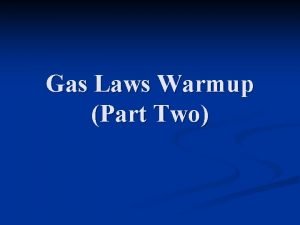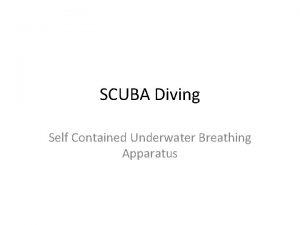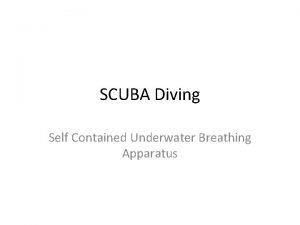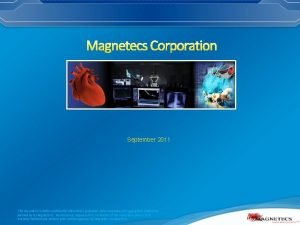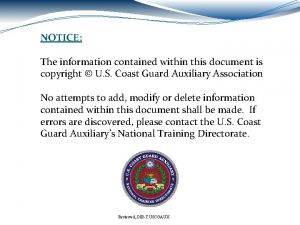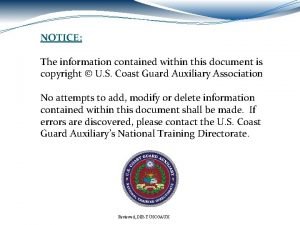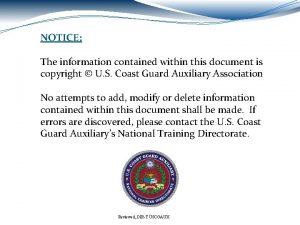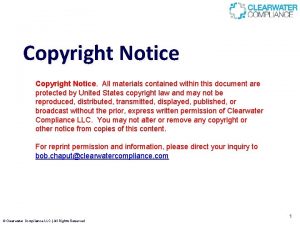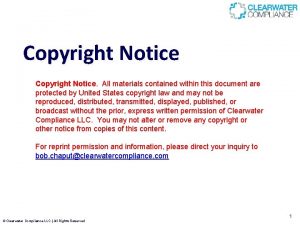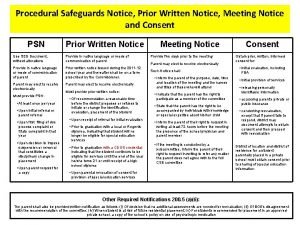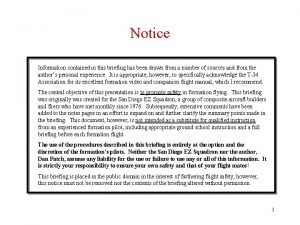NOTICE The information contained within this document is



















![Converting Fahrenheit and Celsius Temperature Conversion: F = [C x 9/5] + 32 [C Converting Fahrenheit and Celsius Temperature Conversion: F = [C x 9/5] + 32 [C](https://slidetodoc.com/presentation_image_h/212b78d3b27d668fe83cf4105313add3/image-20.jpg)























- Slides: 43

NOTICE: The information contained within this document is copyright © U. S. Coast Guard Auxiliary Association No attempts to add, modify or delete information contained within this document shall be made. If errors are discovered, please contact the U. S. Coast Guard Auxiliary’s National Training Directorate. Reviewed, DIR-T USCGAUX

WEATHER Specialty Course AUXWEA Chapter 1 – What Drives the Weather? Reviewed, DIR-T USCGAUX

Overview of the AUXWEA course. Solar radiation, heat and temperature: The relationship between solar energy and weather. Energy balance in the atmosphere. Temperature and temperature scales. Specific Heat—its definition and importance. Types of energy transfer within and between objects. Global winds and the Coriolis Effect. Global wind and pressure patterns. The impact of Earth’s rotation on the nature of global winds. Reviewed, DIR-T USCGAUX 3

Section 1 Introduction to the AUXWEA Course Reviewed, DIR-T USCGAUX 4

Purpose of the Course This course is designed to give an Auxiliarist, whether pilot, coxswain, or crew, a basic understanding of meteorology and weather phenomena so they can be safer and more effective in their roles. By necessity, it includes some very simple physical principles, but nothing above high school level. It will not make observers or forecasters of you, but will teach you how to make use of the vast stores of information about current and forecast conditions. The focus at the end of the course is on education about weather dangers and how to avoid or overcome them. Reviewed, DIR-T USCGAUX 5

Course Outline Part I—The Science of Meteorology. Chap 1—What Causes the Weather? Chap 2—Pressure and Winds. Chap 3—Moisture, Latent Heat and Stability. Part II—The Wide Variety of Weather Phenomena. Chap 4—Air Masses, Fronts and Cyclones. Chap 5—Clouds, Precipitation and Optical Phenomena. Chap 6—Severe Weather. Part III—How do I Apply This Information? Chap 7—Observation and Forecast Data Sources. Chap 8—Preparing for and Executing a Mission. Reviewed, DIR-T USCGAUX 6

How to Approach Your Study First, be sure to read the text and answer the study questions PRIOR to class. This PPT presentation is simply an opportunity to generate discussion, answer questions, and provide a review of the material. You should read the study guide prior to coming to class. If you are unsure about something in the material, ask the instructor and/or discuss it with your fellow students. Appendices A and B in the Student Study Guide have more information that can take your knowledge to the next level. You are not responsible for this content. Finally, approach the course with a sense of adventure and have fun! Reviewed, DIR-T USCGAUX 7

Some Basic Definitions Meteorology is the science of the atmosphere, its physical characteristics and principles, including weather in all its forms. Weather is the current state of the atmosphere or its forecast state, at a given time or for a given time span, and for a given place or a defined area. Climate is the long-term average of the weather at a given location or over a defined area. Typical time spans are 30 years or more. Reviewed, DIR-T USCGAUX 8

Section 2 Solar Radiation, Heat and Temperature Reviewed, DIR-T USCGAUX 9

Overview The importance of solar energy. Spectrum. Variation with latitude and season. Distribution within the atmosphere. The nature of energy and heat. Temperature. Types of energy. Heat as the manifestation of energy. The common temperature scales. The nature and importance of Specific Heat. The transfer of energy. Reviewed, DIR-T USCGAUX 10

Solar Radiation The Sun is a large thermonuclear furnace that derives its energy from the fusion of hydrogen. It radiates energy at all wavelengths, with the peak in the visible (green) part of the spectrum. It also emits large amounts of energy in the infrared and ultraviolet portions of the spectrum. Besides the visible, the ultraviolet energy is important in the energy balance of the upper atmosphere (more in Chap 3). The very small portion of the total solar output that arrives at the Earth has a profound effect on the weather. Reviewed, DIR-T USCGAUX 11

The Solar Spectrum The sun radiates as though it had an average temperature of 5, 250 °C (black line) The yellow shows the spectrum at the top of the atmosphere. The red spectrum is at sea level, after the atmosphere has absorbed and reflected part of the energy. A nm is one billionth of a meter. Reviewed, DIR-T USCGAUX 12

Distribution of Solar Energy Radiation that impinges straight down on a surface deposits more energy per unit area than one that impinges at an angle. The solar energy at the equator is therefore more concentrated than at the poles. © 1997, USA Today. Reprinted with permission Reviewed, DIR-T USCGAUX 13

The Effect of Seasons © 1997, USA Today. Reprinted with permission The Earth’s axis tilts by 23. 5°. As it revolves around the Sun, its axis points in various directions relative to the Sun, but always to Polaris. The northern and southern hemispheres receive more energy at certain times of the year. Northern in June and southern in December. Same amounts in March and September. Reviewed, DIR-T USCGAUX 14

Energy Balance in the Atmosphere Reflected Solar Energy © 1997, USA Today. Reprinted with permission Not all Solar energy is absorbed at the surface. Clouds and dust scatter visible light. Bright surfaces reflect more than dark surfaces. Reviewed, DIR-T USCGAUX 15

Energy Balance (continued) Courtesy of Intergovernmental Panel on Climate Change Once absorbed, energy is re-radiated and re-absorbed many times over, in the infrared portion of the spectrum. It balances at the surface and the top of the atmosphere. Reviewed, DIR-T USCGAUX 16

Temperature and Heat Temperature is a measure of the average kinetic energy of molecules in an object. Thermal energy (e. g. calories) is the total kinetic energy of molecules in an object. Heat is thermal energy being transferred from one object to another. Heat always flows from the hotter object to the colder one. Reviewed, DIR-T USCGAUX 17

What is Temperature? COLD Less kinetic energy Molecules move slower In cold air Mercury doesn’t rise WARM More kinetic energy Molecules move rapidly in warm air causing mercury to rise © 1997, USA Today. Reprinted with permission A measure of kinetic energy—molecular motion. Reviewed, DIR-T USCGAUX 18

The Two Primary Temperature Scales Water boils (at 1 atmosphere) 212° 100° 32° 0° Fahrenheit Celsius Ice melts © 1997, USA Today. Reprinted with permission Reviewed, DIR-T USCGAUX 19
![Converting Fahrenheit and Celsius Temperature Conversion F C x 95 32 C Converting Fahrenheit and Celsius Temperature Conversion: F = [C x 9/5] + 32 [C](https://slidetodoc.com/presentation_image_h/212b78d3b27d668fe83cf4105313add3/image-20.jpg)
Converting Fahrenheit and Celsius Temperature Conversion: F = [C x 9/5] + 32 [C x 2, minus 10%] C = ( F - 32 ) x 5/9 Approx. {(F-32) plus 10%} / 2 Reviewed, DIR-T USCGAUX 20

Specific Heat is defined as the energy it takes to raise a fixed amount of substance by a fixed number of degrees. The units normally used in Meteorology are calories per gram per degree Celsius. This calorie is the gram-calorie (cal). For measuring food energy the Kilogram-calorie (Kcal) is used. It is a thousand times as large as the calorie. The calorie is defined by the Specific Heat of water—the amount of energy it takes to raise one gram of water one °C. The specific heats of soil, vegetation, etc. are lower than water, so they heat and cool faster (more in Chap 3). Reviewed, DIR-T USCGAUX 21

How Energy is Transferred There are three common methods to transfer heat energy from one object to another, or from one part of an object to another: Conduction—molecular motion transferred from one molecule to another. Occurs in solids and liquids, but very little in gases. Convection—the physical movement of parts of the substance, usually vertically, as in heated water. Also occurs in gases. In meteorology, horizontal movement is called advection. Radiation—the remote transfer of energy by electromagnetic radiation. It does not require a medium for transfer, it is actually more efficient in a vacuum. Examples of each of these are on the next slide. Reviewed, DIR-T USCGAUX 22

Methods of Energy Transfer Conduction Convection Radiation Reviewed, DIR-T USCGAUX 23

Station Model--Temperature Weather measurements are plotted on surface charts in a specific way. Shown here is the station, represented by the circle, and the temperature in °F. We will add other data as the class continues. Reviewed, DIR-T USCGAUX 24

Section 3 Global Circulation and the Coriolis Effect Reviewed, DIR-T USCGAUX 25

Overview The Coriolis Effect. What it is and what it is not. How it affects winds. Global Circulation. Without Coriolis. With Coriolis. Pressure bands. Prevailing winds. Effect of oceans and continents. Reviewed, DIR-T USCGAUX 26

What is the Coriolis Effect? A term added to equations of motion when converted from a fixed (inertial) to a rotating reference frame (the Earth). The Coriolis Effect has several properties: It causes winds to curve to the right in the northern hemisphere. It causes winds to curve to the left in the southern hemisphere. It increases with increasing Latitude (zero at the equator). It increases with increasing wind speed. It is effective only over long distances {NOT in sinks!}. Although it is not a true force, it behaves like one. A simplified picture of why it exists is on the next slide. Reviewed, DIR-T USCGAUX 27

Why is There a Coriolis Effect? © 1997, USA Today. Reprinted with permission The disk is rotating like the Earth viewed from above the north pole. The man draws what appears to him to be a straight line (like a ball thrown in space). An observer on the disk (Earth) will observe the line curving. Reviewed, DIR-T USCGAUX 28

Global Circulation on a Nonrotating Earth Heat causes air at the equator to rise. It sinks when it reaches the poles. Winds at the surface blow from the poles. This circulation is called a Hadley cell. The Coriolis Effect changes this model. Reviewed, DIR-T USCGAUX Courtesy of NOAA 29

Global Circulation on a Rotating Earth With the Coriolis Effect, a single Hadley cell is not stable and breaks into three cells. Where air rises, the surface pressure is low. Where air falls, the surface pressure is high. Coriolis also affects the direction of the winds. Polar Cell Ferrel Cell Hadley Cell Reviewed, DIR-T USCGAUX Courtesy of NOAA 30

Cross-section, with Jet Streams Courtesy of NOAA Reviewed, DIR-T USCGAUX 31

Pressure Bands © 2008, US Power Squadrons. Reprinted with permission Reviewed, DIR-T USCGAUX 32

Prevailing Winds The three cells and the resulting pressure bands cause surface winds. The Coriolis Effect bends the winds. The prevailing winds are: The Trade Winds. The Prevailing Westerlies. The Polar Easterlies. © 2008, US Power Squadrons. Reprinted with permission Reviewed, DIR-T USCGAUX 33

Global Circulation Summary Courtesy of University of Connecticut Reviewed, DIR-T USCGAUX 34

Summary of Global Circulation From the equator to the poles, the pressure bands are: Equatorial low, called the Doldrums (light winds). Mid-latitude highs, called the Horse Latitudes (also light winds). The sub-polar lows. The polar highs. The winds are: Northeast and southeast trade winds. Prevailing westerlies. Polar easterlies. This simple picture is complicated by the continents. Reviewed, DIR-T USCGAUX 35

Effects of Continents and Oceans © 1997, USA Today. Reprinted with permission Reviewed, DIR-T USCGAUX 36

Summary (1 of 3) Meteorology is the scientific study of the atmosphere. Weather is the current or forecast state of the atmosphere. Climate is the average of the weather over a long period. The Sun is the source of all energy driving the weather. More solar energy falls on the equator than on the poles. Axial tilt and the Earth’s orbit drive seasonal changes. The energy balance of the Earth is complex and ever changing. The Sun’s energy is strongest in the visible portion of the spectrum, the Earth’s is strongest in the Infrared. Reviewed, DIR-T USCGAUX 37

Summary (2 of 3) Temperature is due to the average kinetic energy of atoms The main temperature scales are Fahrenheit and Celsius. Pure ice melts at 32 °Fahrenheit or 0 °Celsius. At standard pressure, pure water boils at 212 °F or 100 °C Specific heat is the energy required to raise the temperature of one gram of a substance by 1° C. A calorie is defined as the specific heat of pure water. Heat energy is transported by conduction, convection and radiation. In meteorology, horizontal transport is an analog of convection, called advection. Reviewed, DIR-T USCGAUX 38

Summary (3 of 3) Global circulation is driven by unequal heating between the equator and the poles and is modified by the Coriolis effect. The Coriolis effect is due to the Earth’s rotation and acts like a force, but is not one. It increases with increasing wind speed and increasing latitude and operates only over long distances. From the equator to the poles, the pressure belts are: The doldrums (low), horse latitudes (high), sub-polar lows, and polar highs. Land oceans break these into semi-permanent highs and lows. The wind belts are: The trade winds (easterly), the prevailing westerlies, and the polar easterlies. Reviewed, DIR-T USCGAUX 39

Chapter 1 Questions QUESTION ANSWER How does the amount of energy per unit area that arrives at the top of the atmosphere change with latitude? The largest temperature swings are: With the same heat input, do the oceans or land heat faster? The Specific Heat of a substance is: Temperature is defined as: Decreases with increasing latitude. With the seasons. The land. The rate of temperature increase for a given energy input. A measure of the average kinetic energy of molecules. Reviewed, DIR-T USCGAUX 40

Chapter 1 Questions QUESTION ANSWER A temperature of 0° Celsius is: The melting point of pure water ice. The transfer of heat by the horizontal movement of air is: Advection. The transfer of heat between bodies that are not in contact is: Radiation. The vertical movement of air is called: Winds near the equator are called: Convection. Trade Winds. Reviewed, DIR-T USCGAUX 41

Chapter 1 Questions QUESTION ANSWER The region of low pressure near the equator is called: The doldrums. The Intertropical Convergence Zone (ITCZ) is located: Near the equator. Heat is transported north and south from the equator by: Winds and ocean currents. The region of relatively high pressure near 30° latitude is known as the: Horse Latitudes. How does the Coriolis Effect vary with latitude? Increases with increasing latitude. Reviewed, DIR-T USCGAUX 42

End of Chapter 1 Do you have any questions? Chapter 2 covers Pressure and Winds Reviewed, DIR-T USCGAUX
 The newspaper report contained important information
The newspaper report contained important information Document
Document Information notice
Information notice Which letter indicates when dinosaurs became extinct
Which letter indicates when dinosaurs became extinct A sample of gas in a rigid cylinder
A sample of gas in a rigid cylinder Why must an arcing device be contained
Why must an arcing device be contained Which colonial region contained rocky soil and cold climate
Which colonial region contained rocky soil and cold climate Earths early atmosphere contained
Earths early atmosphere contained Contained rock asphalt mat
Contained rock asphalt mat Epubtest
Epubtest Rzeczp
Rzeczp Animals figures of speech
Animals figures of speech The potion contained fruit biscuits and glue
The potion contained fruit biscuits and glue Self contained underwater breathing apparatus
Self contained underwater breathing apparatus Self contained underwater breathing apparatus
Self contained underwater breathing apparatus What problems did this election underscore?
What problems did this election underscore? Enable contained databases
Enable contained databases Is a cornerstone in the protection of information assets
Is a cornerstone in the protection of information assets This document contains confidential information
This document contains confidential information This document contains confidential information
This document contains confidential information This document contains confidential information
This document contains confidential information Hát kết hợp bộ gõ cơ thể
Hát kết hợp bộ gõ cơ thể Slidetodoc
Slidetodoc Bổ thể
Bổ thể Tỉ lệ cơ thể trẻ em
Tỉ lệ cơ thể trẻ em Chó sói
Chó sói Chụp phim tư thế worms-breton
Chụp phim tư thế worms-breton Chúa yêu trần thế alleluia
Chúa yêu trần thế alleluia Môn thể thao bắt đầu bằng từ đua
Môn thể thao bắt đầu bằng từ đua Thế nào là hệ số cao nhất
Thế nào là hệ số cao nhất Các châu lục và đại dương trên thế giới
Các châu lục và đại dương trên thế giới Công của trọng lực
Công của trọng lực Trời xanh đây là của chúng ta thể thơ
Trời xanh đây là của chúng ta thể thơ Mật thư tọa độ 5x5
Mật thư tọa độ 5x5 101012 bằng
101012 bằng Phản ứng thế ankan
Phản ứng thế ankan Các châu lục và đại dương trên thế giới
Các châu lục và đại dương trên thế giới Thơ thất ngôn tứ tuyệt đường luật
Thơ thất ngôn tứ tuyệt đường luật Quá trình desamine hóa có thể tạo ra
Quá trình desamine hóa có thể tạo ra Một số thể thơ truyền thống
Một số thể thơ truyền thống Cái miệng nó xinh thế
Cái miệng nó xinh thế Vẽ hình chiếu vuông góc của vật thể sau
Vẽ hình chiếu vuông góc của vật thể sau Biện pháp chống mỏi cơ
Biện pháp chống mỏi cơ đặc điểm cơ thể của người tối cổ
đặc điểm cơ thể của người tối cổ




